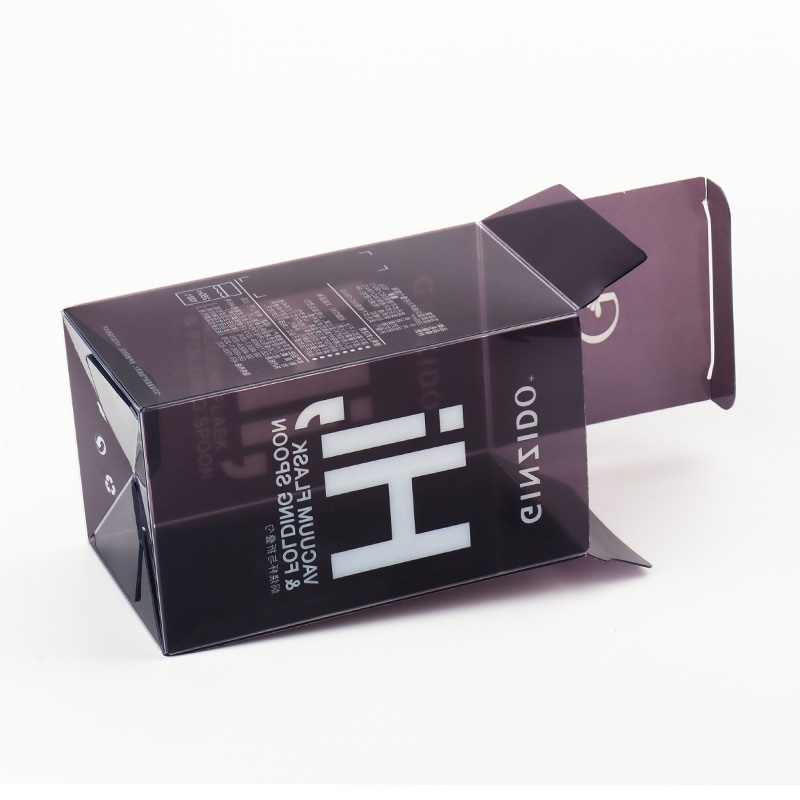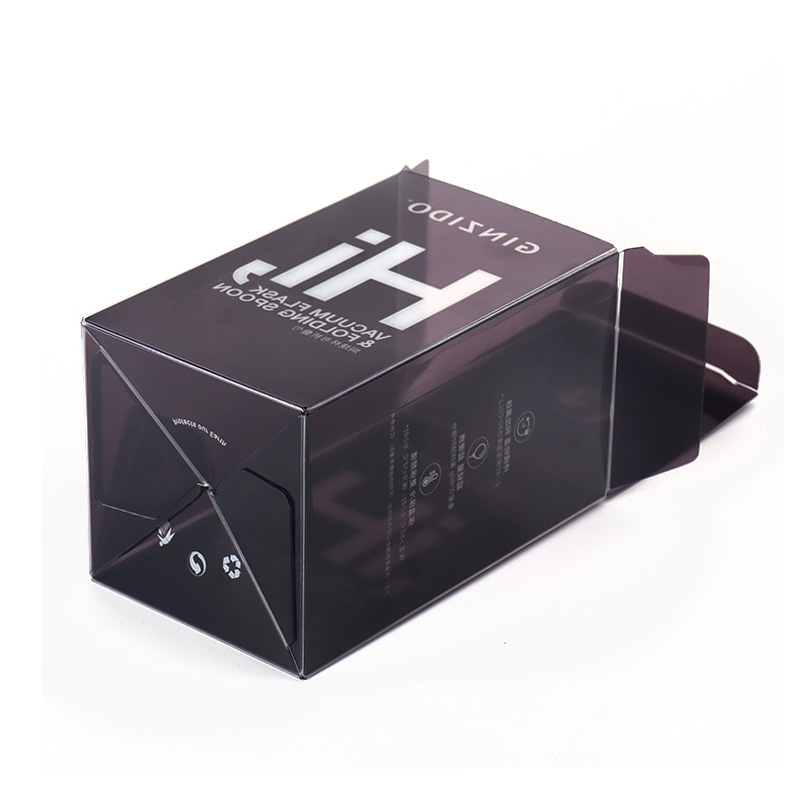PET color-printed square folding plastic boxes are mostly made of PVC film, PET film, and PP film. These materials are glossier than paper materials. After the offset printing process, the appearance of PET color boxes and PP color boxes is more beautiful, brighter and more upscale.
This PET color printed square folding plastic is the first choice for packaging of various popular products such as food, gifts, cosmetics, clothing and retail goods. Made from plastic materials such as PVC, PET and PP, these boxes are lightweight and durable, and can be easily printed with high-quality designs and logos.
In terms of printing technology, transparent plastic boxes have the unique advantage of transparency, allowing consumers to see the product packaging inside at a glance. There are many choices for the printing process of transparent plastic boxes. Whether you are pursuing practicality or hoping to attract consumers' attention, transparent plastic boxes (PET boxes, PVC boxes and PP boxes) can meet your needs.

pet color printed square folding plastic features
- pet color printed square folding plastic from factory are made from plastic material PET,and are designed to be lightweight, durable, and visually appealing.
- The plastic material used in these boxes is also food-grade and safe for direct contact with food.
- pet color printed square folding plastic from supplier can be printed with high-quality images and designs to enhance the visual appeal of the product and attract potential customers.

What materials are commonly used in the production of PET color-printed square folding plastic boxes?
The following are the primary materials that are often used in the creation of PET color-printed square folding plastic boxes:
- PET plastic: Polyethylene terephthalate is shortened to PET. It is a biodegradable polymer compound that is safe for the environment and non-toxic. 1.33–1.35 g/cm^ is its density. PET has a number of characteristics, including strong chemical stability, minimal water absorption, toughness, and tensile strength. At ambient temperature, PET is also insoluble in most organic and inorganic solvents. PET offers superior mechanical and physical qualities, airtightness, processing efficiency, and resilience to low temperatures. It is very transparent, difficult to break, odourless, and simple to print on.
- PVC film: Polyvinyl chloride, or PVC, is a popular kind of plastic. PVC film is often used to build packing boxes that must bear a lot of pressure and friction because of its excellent toughness and longevity.
- Polypropylene, or PP, is a transparent plastic substance that has exceptional mechanical strength and heat resistance. When creating food packaging and microwave-safe dinnerware that must endure higher temperatures, PP film is often employed.
These materials can guarantee the stability and safety of the packing box during usage and transit because of their great durability and resistance to moisture. Additionally, these materials print well, allowing for the printing of a wide range of beautiful and imaginative patterns and designs on their surfaces to improve the product's competitiveness in the market and brand image.
How do PET, PVC, and PP materials compare to traditional paper in terms of brightness for square folding plastic boxes?
Brightness and gloss-wise, plastic materials like PET, PVC, and PP often outperform conventional paper. This is because plastic materials have more reflecting properties and a smoother surface, which allows them to reflect light more effectively and give the impression of being brighter and glossier.
On the other hand, conventional paper often has a softer matte appearance because of its rough surface and easy absorption of light. Nevertheless, after receiving specific treatment and coating, certain premium papers may also have increased brightness and gloss; however, this treatment often has a larger price tag.
It should be mentioned that throughout the manufacturing process, plastic packing boxes must go through procedures like printing and laminating, which will also have an impact on the final brightness and shine. As a result, careful considerations based on financial constraints and genuine demands must be taken when selecting plastic packing boxes.
What printing technique is employed for PET color boxes, and how does it enhance their aesthetic appeal?
PET colour boxes often use a range of printing methods to accentuate their aesthetic appeal, such as:
- Offset printing technology: Using offset plates, this printing technique produces text and patterns of exceptional quality on PET colour boxes. The final colour effect and printing quality are at your control when you choose various inks and printing process settings.
- UV spray technology: This printing technique prints text and patterns with a high gloss on PET colour boxes. It makes use of UV light-curing ink. Gloss effects and textures may be varied by adjusting the ink concentration, spraying speed, and UV light curing time.
- Hot stamping technology is a printing technique that prints metallic patterns and text on PET colour boxes. It uses specialised metallic ink. The final metallic look and gloss may be tailored by choosing various metallic inks and manufacturing settings.
- Local UV glazing technology: This technique produces unique local gloss and texture on PET colour boxes by applying local UV light curing to the surface of printed materials. You may produce deeper visual effects by adjusting the glazing's area and thickness.
The following elements may be taken into account in order to improve PET colour boxes' aesthetic appeal:
- Select the right printing method: To get the best texture and colour effect, select the printing method that best suits your demands and budget, such as offset printing, UV spraying, hot stamping, etc.
- Pay attention to colour matching: To improve the overall attractiveness of the colour box, choose a colour matching that complements the product style and brand image.
- Design creative elements: To make the colour box more distinctive and eye-catching, use creative aspects into the printing design, such as unique patterns, textures, reliefs, etc.
- Pay attention to details: To enhance the final product's aesthetic appeal, pay close attention to details such as ink consistency, colour correctness, and orderly arrangement throughout the printing process.

In which industries are PET color-printed square folding plastic boxes commonly used?
PET color printed square folding plastic boxes are widely used in various industries, especially suitable for occasions that require exquisite packaging and high-end feel. Here are a few typical application industries:
- Food industry: Because of its excellent sealing, moisture-proof, and shock-proof qualities, PET color-printed square folding plastic boxes are often used to package food items like sweets, chocolates, biscuits, etc. Food's brand image and competitiveness in the market may be improved by its vivid look and superior printing performance.
- Cosmetics industry: Square folding plastic boxes with PET colour printing are appropriate for packaging cosmetics including foundation, eye shadow, and lipstick. Its luxurious feel and gorgeous look may draw in customers and increase the product's added value.
- Present industry: Because of their superior printing technology and customisable characteristics, PET color-printed square folding plastic boxes are often used for present wrapping, including jewellery boxes, watch boxes, greeting cards, and so on. Its eye-catching look and imaginative design might add to the gift's originality and sentimental value.
- Clothing industry: Packaging shirts, skirts, shoes, and other items of clothing may be done using PET color-printed square folding plastic boxes. Its recyclable, strong, and lightweight qualities improve the brand's reputation while also adhering to environmental regulations.
- Retail commodity industry: Square folding plastic boxes with PET colour printing are appropriate for a range of retail goods, including toys, stationery, electronics, and more. The product's attractive look and adaptable characteristics make it more competitive in the market.
In summary, because of their superior physical, printing, and environmental protection qualities, PET color-printed square folding plastic boxes have a wide range of applications potential across several sectors.
What printing technologies are involved in the production of plastic packaging boxes, and how do they contribute to the design quality?
A range of printing processes are used in the manufacture of plastic packing boxes. The following factors primarily demonstrate how these technologies improve design quality:
- Colour effects: The restoration and replication of colour depend heavily on printing technique. The display of colour is affected differently by various printing methods. Selecting the right printing process may enhance the product's aesthetic appeal and guarantee that the colours in the design are correctly conveyed to customers.
- Printing clarity: The way the design looks on the plastic packing box is determined by the printing clarity. High-definition printing technique can guarantee distinct lines and all of the design's nuances, enhancing the texture and complexity of the piece overall.
- Realisation of special effects: Printing processes like hot stamping and local UV glazing may produce various unique effects. These elements may give the design more depth and individuality, helping it to stick out on the shelf.
- Customisation to customer specifications is made possible by modern printing technology. For example, designers may add text, numbers, or patterns to packing boxes to better serve the specific demands of their clients while also bringing the design's humanity and personality to life. shift.
- Material adaptability: Various printing techniques may be used to a variety of materials. In order to guarantee the adherence and adaptability of the design on the material and prevent the loss of design impact due to material difficulties, designers must choose the proper printing process based on the composition of the plastic packing box.
In summary, colour effects, printing clarity, the realisation of special effects, personalised customisation, and material adaptability are some of the ways that printing technology contributes to the quality of design in the creation of plastic packing boxes. By selecting the right printing process and modifying technical specifications in accordance with design requirements, plastic packing boxes may have better designs and become more competitive in the market.

What plastic packaging is best for food?
When it comes to choosing plastic packaging for food products, it is essential to consider factors such as safety, durability, and the ability to protect the food product from external factors such as moisture, oxygen, and light.
- Polyethylene terephthalate (PET): PET plastic is a common material used in food packaging. It is clear, lightweight, and has excellent barrier properties, which make it ideal for packaging beverages, salads, sandwiches, and other food products.
- Polypropylene (PP): PP plastic is another popular material used in food packaging. It is strong, lightweight, and has a high melting point, making it ideal for packaging hot foods such as soups, sauces, and microwave meals.
- Polyvinyl chloride (PVC): PVC plastic is commonly used in food packaging, but it is important to note that not all PVC packaging is suitable for food. Only food-grade PVC should be used to package food products as it is safe, durable, and has excellent barrier properties.

































